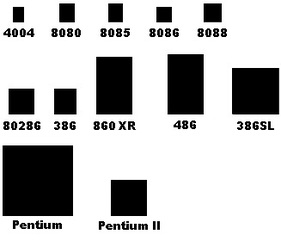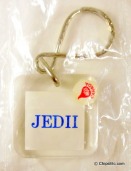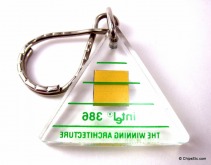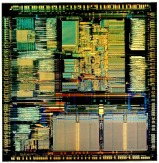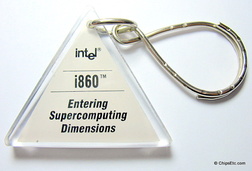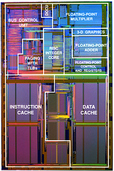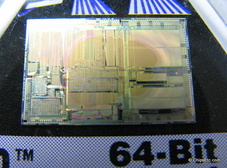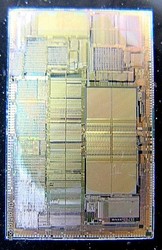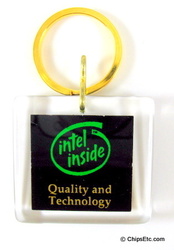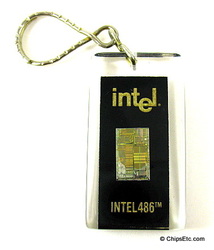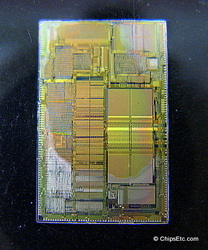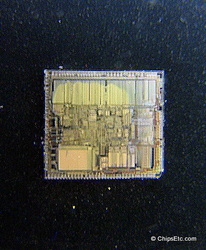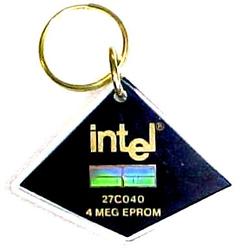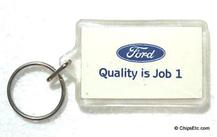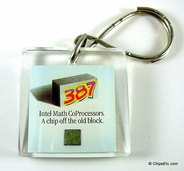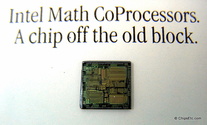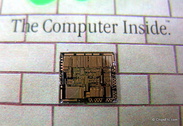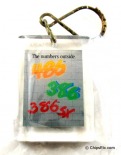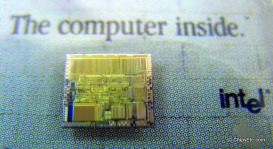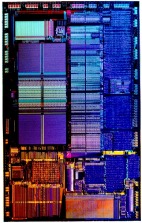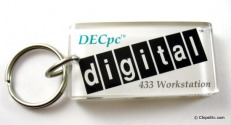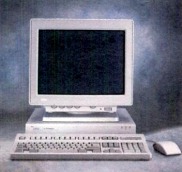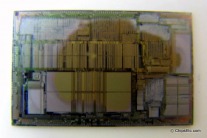Since the 1980's, Intel has been promoting their famous line of CPU & Memory computer chips with samples of their chips embedded in Lucite and made into keychains.
Typically, the Intel computer chips used in these promotional keychains were actual production chips that were rejected for not meeting Intel's quality or reliability standards during their final electrical testing.
Intel Keychains were given out to employees to recognize a new product release or corporate milestone achievement, given away as sales promotions at computer & electronics trade-shows, or offered for sale to the public at the Intel Gift Stores located at select Intel campuses, as well as at The Intel Museum gift store in Santa Clara.
During the mid 1990's Intel also had some defective Pentium CPU chips mounted into gold plated promotional keychains & jewelry that were offered for sale to the public at a few of the larger U.S. University's and Museums.
Intel 1MB CHMOS DRAM Memory Chip Keychain (1985)
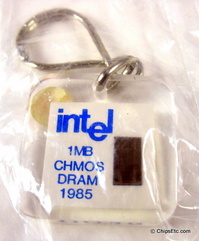
Item #469
This is one of the oldest Intel Keychains in our collection. This keychain has an actual Intel 1MB (1 Megabit) memory chip embedded in it. On the back it says "JEDII".
Intel was the first to produce the DRAM memory chip (the Intel 1103) back in 1970. The Intel 1MB DRAM memory chip was developed in 1984 and was planned to go into full production in 1985 at Fab 5 in Aloha Oregon. However, Intel would decide to completely exit the DRAM memory chip business in 1985 and stop the last DRAM production at Fab 5.
Item is new in sealed bag.
Intel was the first to produce the DRAM memory chip (the Intel 1103) back in 1970. The Intel 1MB DRAM memory chip was developed in 1984 and was planned to go into full production in 1985 at Fab 5 in Aloha Oregon. However, Intel would decide to completely exit the DRAM memory chip business in 1985 and stop the last DRAM production at Fab 5.
Item is new in sealed bag.
Intel 386 CPU Chip Keychain: The Winning Architecture (1985)
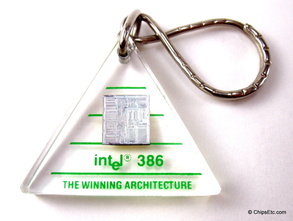
Item #484
The Intel 80386, also known as the i386, or just 386, was a 32-bit Microprocessor introduced by Intel in 1985. The first versions had 275,000 transistors and were used as the CPU of many Personal Computers and Workstations.
Intel 386 CPU Chip Keychain - Essence of Fine Computing (1985)
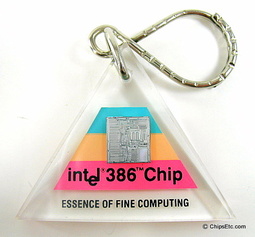
Item #592
Another Intel keychain featuring a 386 Microprocessor chip embedded in Lucite.
Reads "Intel 386 Chip, Essence of fine computing" and has three color graphics.
Reads "Intel 386 Chip, Essence of fine computing" and has three color graphics.
Intel Inboard 386 CPU Chip Keychain (1988)
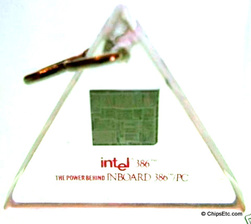
Intel offered an Inboard 386 accelerator board that you could plug into your old motherboard that could be used to upgrade a 286 system to a 386 an increase performance.
Intel i860 80860 Supercomputer 64-bit RISC Processor Chip (1989)
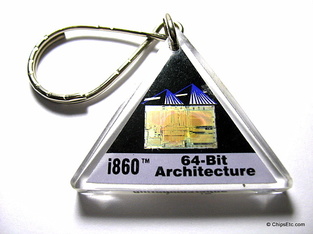
Item #595
This Lucite keychain has an actual Intel i860 RISC processor chip (also known as the Intel 80860). On the back it reads "Intel i860 / Entering Supercomputing Dimensions".
The Intel i860, introduced in 1989, was designed to deliver supercomputer performance in a single VLSI chip.
The 64-bit design of the i860 balanced integer, floating point, and graphic performance, and its architecture made it suitable for many supercomputer & other professional applications including engineering workstations, scientific computing, 3-D graphics workstations, and multi-user systems. The chip was available in speeds of 25 to 50 MHz.
Unfortunately, the Intel i860 processor never achieved commercial success and the project was terminated in the mid-1990s.
Triangular shaped keychain measures 1-3/4" on it's sides.
The Intel i860, introduced in 1989, was designed to deliver supercomputer performance in a single VLSI chip.
The 64-bit design of the i860 balanced integer, floating point, and graphic performance, and its architecture made it suitable for many supercomputer & other professional applications including engineering workstations, scientific computing, 3-D graphics workstations, and multi-user systems. The chip was available in speeds of 25 to 50 MHz.
Unfortunately, the Intel i860 processor never achieved commercial success and the project was terminated in the mid-1990s.
Triangular shaped keychain measures 1-3/4" on it's sides.
Intel 386 & 486 "Tomorrow's Vision" CPU Keychain (1989)
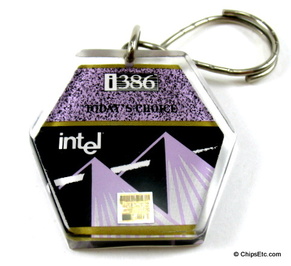
Item #196 (#032, 197, 198 & 583 similar)
Intel double side hexagonal keychain with an actual i386 chip on one side an a i486DX chip on the other.
The background graphics on this keychain are showing pyramids of sand, and reads "today's choice" (the i386) and "tomorrows vision" (the i486).
Both of these chips were manufactured by Intel using the same 1 micron CHMOS IV technology.
Clear Lucite with steel keyring loop measures 1 3/4" tall x 1 5/8" wide.
The background graphics on this keychain are showing pyramids of sand, and reads "today's choice" (the i386) and "tomorrows vision" (the i486).
Both of these chips were manufactured by Intel using the same 1 micron CHMOS IV technology.
Clear Lucite with steel keyring loop measures 1 3/4" tall x 1 5/8" wide.
Intel 486 Microprocessor CPU Chip Keychain (1989)
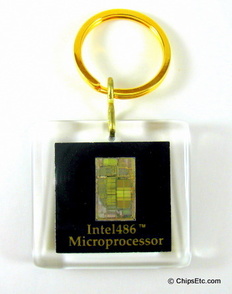
Item #468
The 486 processor was introduced in 1989 to replace the aging 386 family of processors.
Intel 386 & 486 CPU Combo Keychain (1989)
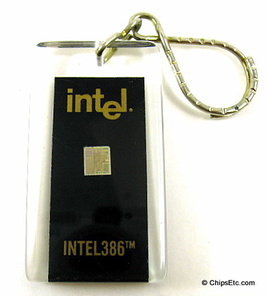
Item #504 (#270, 084, 099, 112, 118 & 572 similar)
"The" classic Intel promotional Lucite keychain!
Contains a real Intel i386 chip embedded on one side and i486 chip embedded on the other side.
Contains a real Intel i386 chip embedded on one side and i486 chip embedded on the other side.
Intel 486 Large Die CPU Keychain (1989)
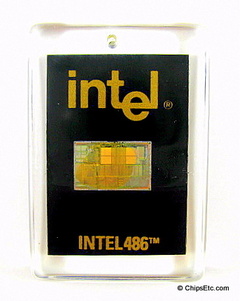
Item #082 (#042 similar)
Another version of the classic, black and gold lettered, Intel 486 CPU keychain.
VIDEO: Intel the Computer Inside - 486 Microprocessor Commercial (1990)
Intel "The Computer Inside" 386 Processor Keychain (1990)
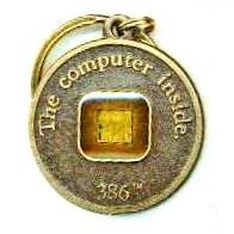
Sold
In 1990, with the advent of it's new 486 processor, Intel became the first CPU maker to promote the idea that it's microprocessors were the "brains" inside the computer. With this new advertising strategy, Intel began targeting computer buyers directly rather than computer marketers. As a result, Intel created a new tag line for their advertising campaigns: "Intel. The computer inside". This was later shortened to "Intel inside" in 1991. Two years later in 1993, the Intel Pentium processor was introduced with much of it's huge success owed to the "Intel Inside" branding campaign created years before.
This bronze keychain has an Intel 386-DX processor mounted on the front and reads "The Computer Inside - 386". This DX version of the Intel 386 processor had 275,000 transistors and was manufactured using 1 micron CHMOS IV technology. It was Intel's first 32-bit desktop computer CPU and was also the first significant microprocessor to be single-sourced.
This bronze keychain has an Intel 386-DX processor mounted on the front and reads "The Computer Inside - 386". This DX version of the Intel 386 processor had 275,000 transistors and was manufactured using 1 micron CHMOS IV technology. It was Intel's first 32-bit desktop computer CPU and was also the first significant microprocessor to be single-sourced.
Intel "The Computer Inside" 486 Processor Keychain (1990)
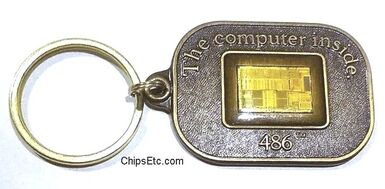
Sold
This bronze keychain, siliair to the one above but has an Intel 486 processor mounted on the front and reads "The Computer Inside - 486".
Intel 512k EPROM Memory Chip Keychain (1990)
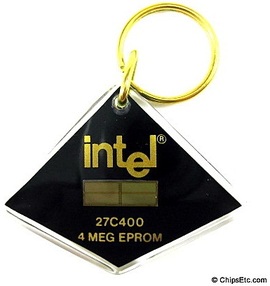
Item #139
The Intel 27C040 was a 5V-only, 4 Megabit UV Erasable, Programmable, Read Only Memory. It was pin compatible (32 pin DIP) with lower density DIP EPROMs (JEDEC) and provided for simple upgrading to 8 Mbits in the future.
Built at Intel's New Mexico Fab 7/9/11, it represented state-of-the-art 1 micron CMOS manufacturing technology while providing unequaled performance.
This EPROM was used in high performance CPUs in applications ranging from video arcade games to numerical control to office automation to telecommunications. The 27C040 was equally at home in both a TTL or CMOS environment. It programmed at a fast 60 seconds using Intel's industry leading Quick-Pulse Programming algorithm.
Intel 4 Mbit (512kb) (512 x 8 CHMOS EPROM 27C040 flash memory chip encased in lucite. Reverse side features an Intel 27C400 EPROM chip.
This is a rare Intel keychain.
Built at Intel's New Mexico Fab 7/9/11, it represented state-of-the-art 1 micron CMOS manufacturing technology while providing unequaled performance.
This EPROM was used in high performance CPUs in applications ranging from video arcade games to numerical control to office automation to telecommunications. The 27C040 was equally at home in both a TTL or CMOS environment. It programmed at a fast 60 seconds using Intel's industry leading Quick-Pulse Programming algorithm.
Intel 4 Mbit (512kb) (512 x 8 CHMOS EPROM 27C040 flash memory chip encased in lucite. Reverse side features an Intel 27C400 EPROM chip.
This is a rare Intel keychain.
Intel Logo Keychain (1980s)

Item #508
Clear rubber flexible keychain with the famous Intel Dropped-e" logo in blue lettering.
Intel / Ford Automotive Computing Keychain (1980s)
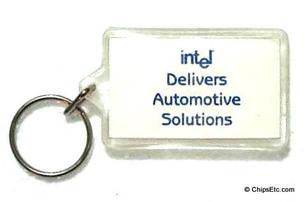
Intel and Ford had a joint venture building EEC ( Electronic Engine Control) chips, also known as the
automotive Electronic Control Unit (ECU's), using custom Intel 8061 chips (based on the Intel 8096 Microcontroller) and later used 8065 chips for the ECU's processing functions.
The 8061 chip and its derivatives were used in almost all Ford automobiles built from 1983 through the end of the 20'th century.
For 17 years, Ford Motor Co. used "Quality is job one," both to convince car buyers of its emphasis on quality and to remind workers of quality's importance
Acrylic keychain.
automotive Electronic Control Unit (ECU's), using custom Intel 8061 chips (based on the Intel 8096 Microcontroller) and later used 8065 chips for the ECU's processing functions.
The 8061 chip and its derivatives were used in almost all Ford automobiles built from 1983 through the end of the 20'th century.
For 17 years, Ford Motor Co. used "Quality is job one," both to convince car buyers of its emphasis on quality and to remind workers of quality's importance
Acrylic keychain.
Intel 1 Millionth 16-bit Microcontroller Chip Keychain (Mid 1980s)
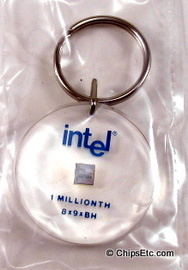
Item #142 (#140 similar)
The MCS-96 family of 8X9XBH 16-bit microcontrollers consisted of many members, all of which were designed for high-speed control functions in embedded systems, including use in automobile systems.
Starting in 1982, Intel offered these microcontrollers in various combinations of on-chip options including with or with-out : 10-bit 4-channel ADC (Analog to digital converter), 8Kb of either ROM or EPROM memory.
Standard on-chip features on all models included a 16-bit CPU that ran at either 12, 16, 20, 25 & 50 MHz, 256 bytes of register ram and 232 bytes of RAM memory.
They were offered in both 48-pin PGA/PLCC and 68-pin DIP packaging and were manufactured by Intel using their HMOS-III process.
Products under this group of microcontrollers include the Intel 8095, 8096, 8097, 8395, 8396, and 8397.
Starting in 1982, Intel offered these microcontrollers in various combinations of on-chip options including with or with-out : 10-bit 4-channel ADC (Analog to digital converter), 8Kb of either ROM or EPROM memory.
Standard on-chip features on all models included a 16-bit CPU that ran at either 12, 16, 20, 25 & 50 MHz, 256 bytes of register ram and 232 bytes of RAM memory.
They were offered in both 48-pin PGA/PLCC and 68-pin DIP packaging and were manufactured by Intel using their HMOS-III process.
Products under this group of microcontrollers include the Intel 8095, 8096, 8097, 8395, 8396, and 8397.
Intel 486 CPU Small Die Keychain (1990)
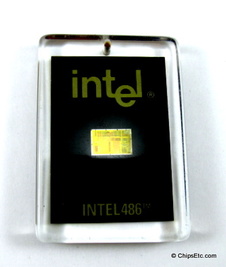
Item #141 (#128 & 147 similar)
Another classic Intel promotional keychain.
This one contains a real 486 chip embedded on one side with 486 circuitry image on the other. Chip is embedded in Lucite.
This one contains a real 486 chip embedded on one side with 486 circuitry image on the other. Chip is embedded in Lucite.
Intel 386 / 387 CPU and Co-Processor Chip Keychain (1990)
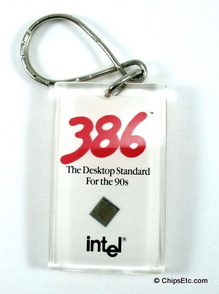
Item #035
The Intel 80387 (387 or i387) was the math co-processor for the 80386 series of Microprocessors, and the first Intel co-processor to implement the IEEE 754 standard in every detail. It was used to perform floating point arithmetic operations directly in hardware.
The i387 was compatible only with the standard i386 chip; the cut down i386SX had its own co-processor, the Intel 80387SX, that could work with the SX's narrower data bus.
The coprocessor was released in 1987, two years after the 386 chip. It included much improved speed and commands over previous FPUs (80287 and 8087).
The 80387 included full coverage of the trigonometric functions, Intel's previous offerings being limited to an argument range of plus or minus 45 degrees.
The i387 was compatible only with the standard i386 chip; the cut down i386SX had its own co-processor, the Intel 80387SX, that could work with the SX's narrower data bus.
The coprocessor was released in 1987, two years after the 386 chip. It included much improved speed and commands over previous FPUs (80287 and 8087).
The 80387 included full coverage of the trigonometric functions, Intel's previous offerings being limited to an argument range of plus or minus 45 degrees.
Intel 386 CPU / 387 Co-Processor "Computer Inside" Keychain (1991)
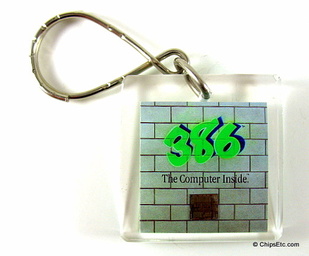
Item #571
The 80387 (387 or i387) was the first Intel Math Co-Processor to be fully compliant with the IEEE 754 standard. Released in 1987, a full two years after the 386 CPU, the i387 included much improved speed over Intel's previous 8087/80287 Co-processors, and improved the characteristics of trigonometric functions. (The 80287 limited the argument range to plus or minus 45 degrees.)
Without a Co-processor, the 386 normally performed floating-point arithmetic through (slow) software routines, implemented at run-time through a software exception-handler. When a math Co-Processor is paired with the 386, the coprocessor performs the floating point arithmetic in hardware, returning results much faster than an (emulated) software library call.
The i387 Co-Processor was compatible only with the standard i386 CPU, which had a 32-bit processor bus. The later cost-reduced i386SX, which had a narrower 16-bit data bus, could not interface with the i387's 32-bit bus. The i386SX required its own Co-processor, the Intel 80387SX, which was compatible with the SX's narrower 16-bit data bus.
This is an Intel 386/387 "Chip off the old block" Keychain. On one side of the keychain you'll find an actual Intel 386 CPU embedded in the keychain and on the other side there is a 387 Math Co-Processor.
Measures 1.5" by 1.5".
Intel "The Computer Inside" 386 CPU Keychain (1991)
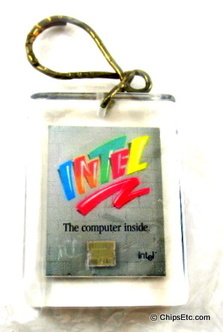
Item #151
The Intel 386 CPU was a 32-bit Microprocessor introduced by Intel in 1985. The first versions had 275,000 transistors.
Has "The numbers outside, 486, 386, 386SX" on the back.
Has "The numbers outside, 486, 386, 386SX" on the back.
Intel "The Computer Inside" 486 Processor Keychain (1991)
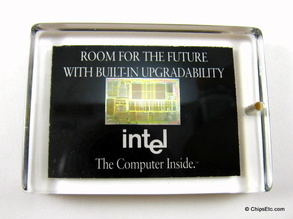
Item #108
Another variation of the Intel 486 CPU keychain.
This one reads "Room for the future with built-in upgradability" & has the pre "intel inside" tagline; "The computer inside".
This one reads "Room for the future with built-in upgradability" & has the pre "intel inside" tagline; "The computer inside".
Intel 486 CPU "The Computer Inside" DEC PC Keychain (1991)
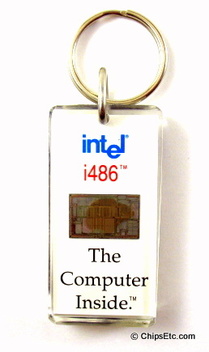
Item #089
When Intel lost court battles in the late 1980's to trademark it's 386 & 486 chips, Intel had to come up with a new identity, one that it could trademark.
The Intel Inside Ad Program was launched in 1991 but during initial Ad development Intel briefly used the tag-line "The computer Inside", this was later shortened to "Intel Inside" in 1993.
The DECpc 433 workstation from Digital Equipment Corp. (DEC) was a leading edge desktop computer that had and Intel 486 processor (could be upgraded to Intel Pentium overdrive processors at a later date) and could run DOS 5.0 with Windows 3.0 and had a 3.5" floppy drive.
This is a 33mhz 486SX chip. The back of the keychain reads "INTEL DECpc DIGITAL 433 Workstation".
The Intel Inside Ad Program was launched in 1991 but during initial Ad development Intel briefly used the tag-line "The computer Inside", this was later shortened to "Intel Inside" in 1993.
The DECpc 433 workstation from Digital Equipment Corp. (DEC) was a leading edge desktop computer that had and Intel 486 processor (could be upgraded to Intel Pentium overdrive processors at a later date) and could run DOS 5.0 with Windows 3.0 and had a 3.5" floppy drive.
This is a 33mhz 486SX chip. The back of the keychain reads "INTEL DECpc DIGITAL 433 Workstation".
